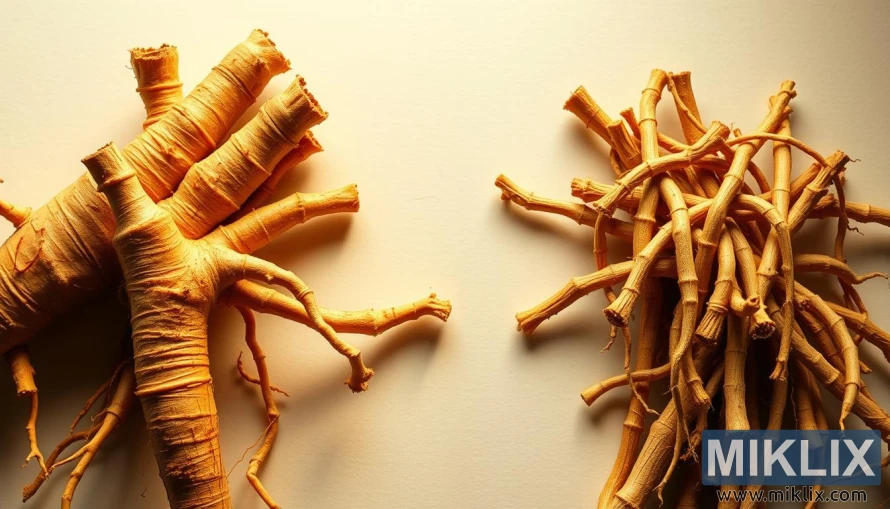Image: Asian vs American ginseng
Published: June 18, 2025 at 8:24:19 AM UTC
Last updated: September 26, 2025 at 9:34:34 AM UTC
Close-up comparison of Asian and American ginseng roots, highlighting their distinct shapes, textures, and colors under soft lighting for herbal study.
The image presents a carefully arranged side-by-side comparison of two different varieties of ginseng, each with its own distinct character, form, and story. On the left lies a set of robust, thick Asian ginseng roots (Panax ginseng), their stout bodies and broad, finger-like extensions radiating outward with a certain weight and presence. Their form suggests strength and resilience, almost resembling human limbs, a feature that has historically contributed to the reverence and symbolic association of ginseng with vitality and energy. On the right, a contrasting bundle of American ginseng roots (Panax quinquefolius) creates a striking counterbalance. These roots are finer, more elongated, and delicately intertwined, presenting a wiry, almost intricate network of natural fibers. The juxtaposition of these two varieties highlights not only their visual differences but also the cultural and medicinal distinctions that have developed around them over centuries of traditional use.
The neutral background serves as a quiet stage, ensuring that all attention remains on the roots themselves, their details amplified by the interplay of light and shadow. The warm, indirect lighting falls softly across their textured surfaces, revealing subtle ridges, grooves, and variations in tone. On the Asian ginseng side, the light accentuates the smooth yet rugged skin of the thicker roots, emphasizing their density and grounding presence. Meanwhile, the finer American ginseng roots catch the light differently, their slender bodies casting delicate shadows that give the bundle a sense of intricacy and fragility. Together, the lighting and arrangement elevate the roots from mere botanical specimens into a visually compelling study of natural variation, one that is both scientific and artistic in its presentation.
Beyond their visual contrast, the image invites reflection on the shared heritage and divergent identities of these two ginseng types. Both are celebrated in traditional medicine, but they are valued for slightly different properties: Asian ginseng is often associated with stimulation, energy, and warmth, while American ginseng is thought to offer a more cooling, calming effect. This duality is subtly communicated in their forms—the bold, almost muscular structure of Panax ginseng standing firm in contrast to the more delicate, threadlike elegance of Panax quinquefolius. The comparison becomes more than a visual exercise; it becomes a symbolic representation of balance, of yin and yang, of two natural forces that complement and counter one another in the pursuit of health and harmony.
The composition itself speaks to intention and care, as if these roots have been placed here not just to be looked at, but to be studied, understood, and appreciated. Their placement side-by-side underscores their interconnectedness despite geographic and botanical differences, and the neutral backdrop removes all distractions, allowing viewers to approach them with the curiosity of both a scientist and an admirer of natural beauty. The image resonates with a quiet sense of reverence, acknowledging the long history of ginseng as one of the world’s most esteemed herbal remedies. It conveys an atmosphere that is both earthy and refined, bridging the worlds of traditional healing and modern scientific inquiry.
Altogether, this photograph is not simply a visual record of two plant specimens; it is an artistic meditation on the diversity of nature and the ways in which humans have found meaning, strength, and healing in its forms. Through careful lighting, composition, and contrast, it transforms the ginseng roots into symbols of resilience, adaptability, and cultural heritage. The result is an image that is not only aesthetically pleasing but also deeply evocative, inspiring curiosity about the natural world and respect for the ancient traditions that continue to shape our understanding of health and wellness today.
The image is related to: Harnessing Ginseng: Nature’s Answer to Stress, Stamina, and Cognitive Clarity

